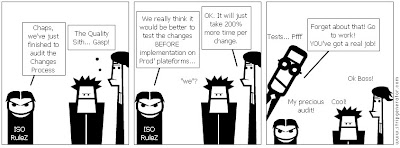
A long time ago, back in the history, the IT Production was a strange room of scientists, performing fundamental research of supercomputers running at 10 Mhz. Everybody wore white shirts, black ties, and held a PhD in either mathematics of physics (or both). Funds came from the army of from big universities, or from the army through big universities. The ultimate goal was research in itself, and everybody was 8-bits happy.
An then came the business.
Factories, banks, phone-operators, public administration… A lot of people wanted some computers to run for their business… But the IT Production was still a bunch of scientists, university nerds, former military researchers, wearing white shirts, black ties, and obsessed by the fundamental research on their computer. The IT Production was an integral part of its corporation, sometimes still under the “Research and Development Department”. Nobody had ever heard of the “Service”, the holy grail of business.
Everything was well, however, since a common knowledge was that “you only need to invest money in the IT to get 20% return on investment yearly”.
Alas, in the merry kingdom of IT Production came, one day, the awakening of the Client.
Was the Client wants is a good service, not fundamental research. He wants a good “bang for the buck”: something like hard tack for his money. And he wants it there and now, not in ten years. And he wants to be able to measure it.
Thus we invented the “Service Levels Agreements”. The IT Production, running like a service provider, will commit itself to a reasonable service level, in accordance with the business needs.
However, everybody soon discovered that it was sometimes hard to turn geeks and nerds into business-centric service providers. And, on the other side, it was sometimes difficult to explain to the Client that the IT Production was not going anymore to be able to go beyond the agreed service level for free… Nobody answered the phone after 5pm anymore. Nobody stayed on week ends for free. You had to pay for just about everything... The SLA is not only a wip for the Client: it is also a shield for the IT Production.
The morale of this story is: “A Service is Defined through three components: its quality, its costs, and its delays”…





















